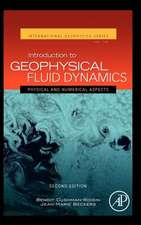Variational Principles of Continuum Mechanics: II. Applications: Interaction of Mechanics and Mathematics
Autor Victor Berdichevskyen Limba Engleză Paperback – 6 noi 2009
Berdichevsky’s work differs from other books on the subject in focusing mostly on the physical origin of variational principles as well as establishing their interrelations. For example, the Gibbs principles appear as a consequence of the Einstein formula for thermodynamic fluctuations rather than as the first principles of the theory of thermodynamic equilibrium. Mathematical issues are considered as long as they shed light on the physical outcomes and/or provide a useful technique for the direct study of variational problems. In addition, a thorough account of variational principles discovered in various branches of continuum mechanics is given.
This book, the second volume, describes how the variational approach can be applied to constructing models of continuum media, such as the theory of elastic plates; shells and beams; shallow water theory; heterogeneous mixtures; granular materials; and turbulence. It goes on to apply the variational approach to asymptotical analysis of problems with small parameters, such as the derivation of the theory of elastic plates, shells and beams from three-dimensional elasticity theory; and the basics of homogenization theory. A theory of stochastic variational problems is considered in detail too, along with applications to the homogenization of continua with random microstructures.
| Toate formatele și edițiile | Preț | Express |
|---|---|---|
| Paperback (2) | 733.46 lei 6-8 săpt. | |
| Springer Berlin, Heidelberg – 6 noi 2009 | 733.46 lei 6-8 săpt. | |
| Springer Berlin, Heidelberg – oct 2009 | 850.13 lei 6-8 săpt. |
Preț: 733.46 lei
Preț vechi: 894.46 lei
-18% Nou
Puncte Express: 1100
Preț estimativ în valută:
140.37€ • 146.00$ • 115.88£
140.37€ • 146.00$ • 115.88£
Carte tipărită la comandă
Livrare economică 14-28 aprilie
Preluare comenzi: 021 569.72.76
Specificații
ISBN-13: 9783540884682
ISBN-10: 3540884688
Pagini: 426
Ilustrații: X, 430 p.
Dimensiuni: 155 x 235 x 33 mm
Greutate: 0.61 kg
Ediția:2010
Editura: Springer Berlin, Heidelberg
Colecția Springer
Seria Interaction of Mechanics and Mathematics
Locul publicării:Berlin, Heidelberg, Germany
ISBN-10: 3540884688
Pagini: 426
Ilustrații: X, 430 p.
Dimensiuni: 155 x 235 x 33 mm
Greutate: 0.61 kg
Ediția:2010
Editura: Springer Berlin, Heidelberg
Colecția Springer
Seria Interaction of Mechanics and Mathematics
Locul publicării:Berlin, Heidelberg, Germany
Public țintă
ResearchCuprins
Some Applications of Variational Methods to Development.- Theory of Elastic Plates and Shells.- Elastic Beams.- Some Stochastic Variational Problems.- Homogenization.- Homogenization of Random Structures: a Closer View.- Some Other Applications.
Recenzii
From the reviews:
“This new book goes far beyond anything currently available concerning variational principles in continuum mechanics. … We have at hand a monument that all students and professionals in applied mathematics, physics and engineering will praise and naturally keep handy on their bookshelf. Teacher will find in the book a wealth of pedagogical material for many one- semester courses. They and their students will appreciate the clarity simplicity and ingenuity of many arguments offered without pedantry and sacrifice of rigour.” (Gerard A. Maugin, Mathematical Reviews, Issue 2011 a)
“This new book goes far beyond anything currently available concerning variational principles in continuum mechanics. … We have at hand a monument that all students and professionals in applied mathematics, physics and engineering will praise and naturally keep handy on their bookshelf. Teacher will find in the book a wealth of pedagogical material for many one- semester courses. They and their students will appreciate the clarity simplicity and ingenuity of many arguments offered without pedantry and sacrifice of rigour.” (Gerard A. Maugin, Mathematical Reviews, Issue 2011 a)
Textul de pe ultima copertă
The book reviews the two features of the variational approach: its use as a universal tool to describe physical phenomena and as a source for qualitative and quantitative methods of studying particular problems.
Berdichevsky’s work differs from other books on the subject in focusing mostly on the physical origin of variational principles as well as establishing their interrelations. For example, the Gibbs principles appear as a consequence of the Einstein formula for thermodynamic fluctuations rather than as the first principles of the theory of thermodynamic equilibrium. Mathematical issues are considered as long as they shed light on the physical outcomes and/or provide a useful technique for the direct study of variational problems. In addition, a thorough account of variational principles discovered in various branches of continuum mechanics is given.
This book, the second volume, describes how the variational approach can be applied to constructing models of continuum media, such as the theory of elastic plates; shells and beams; shallow water theory; heterogeneous mixtures; granular materials; and turbulence. It goes on to apply the variational approach to asymptotical analysis of problems with small parameters, such as the derivation of the theory of elastic plates, shells and beams from three-dimensional elasticity theory; and the basics of homogenization theory. A theory of stochastic variational problems is considered in detail too, along with applications to the homogenization of continua with random microstructures.
Berdichevsky’s work differs from other books on the subject in focusing mostly on the physical origin of variational principles as well as establishing their interrelations. For example, the Gibbs principles appear as a consequence of the Einstein formula for thermodynamic fluctuations rather than as the first principles of the theory of thermodynamic equilibrium. Mathematical issues are considered as long as they shed light on the physical outcomes and/or provide a useful technique for the direct study of variational problems. In addition, a thorough account of variational principles discovered in various branches of continuum mechanics is given.
This book, the second volume, describes how the variational approach can be applied to constructing models of continuum media, such as the theory of elastic plates; shells and beams; shallow water theory; heterogeneous mixtures; granular materials; and turbulence. It goes on to apply the variational approach to asymptotical analysis of problems with small parameters, such as the derivation of the theory of elastic plates, shells and beams from three-dimensional elasticity theory; and the basics of homogenization theory. A theory of stochastic variational problems is considered in detail too, along with applications to the homogenization of continua with random microstructures.
Caracteristici
Concise and understandable book about variational principles of continuum mechanics presenting the classical models Accessible to applied mathematicians, physicists and engineers who have an interest in continuum mechanics Interesting innovative textbook for graduate students Includes supplementary material: sn.pub/extras


























